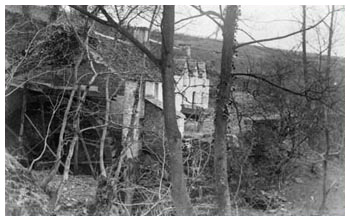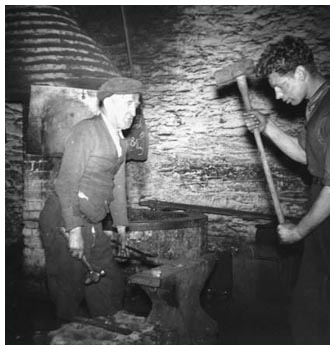
| Ynysybwl | |
The 1842 tithe map and schedules of Llanwonno Parish shows Ynysybwl to be a small village consisting of a few cottages and farms. It was located in the centre of the parish at the point where the Ffrwd flowed into the Clydach river. According to the 1841 census around 200 people inhabited the village and surrounding farms. The majority of them earned their livings as farmers, agricultural labourers or female servants. Other villager's occupations included a blacksmith, timberman, mason, shoemaker, tailor, miller and publican of the Ynysybwl Inn. Very little change occurred over the next forty years apart from the building of the odd cottage. |
The old village of Ynysybwl |
 |
Indeed the 1881 census showed that the population of Ynysybwl and its surroundings had only increased to about 270 inhabitants. Another striking feature of the 1881 census is that not one collier was listed among the villagers. An ordnance survey map published in 1884 shows Ynysybwl on the verge of a transformation. Mynachdy coal level is shown on the map but it was the sinking of Lady Windsor Colliery on June 16th 1884 that was to give birth to new coal town. Left: Pugh's Drapers shop - the family emigrated to Canada during the 1926 strike |
One of the old inhabitants of Ynysybwl who was witnessing this period of incredible change was William Thomas 1843-1890 or Glanffrwd as he was known in literary and eisteddfod circles. Appearing in serial form in the Darian, he wrote Hanes Plwyf Llanwynno in 1888. It provided an excellent description of Llanwonno parish, its natives and their way of life. Right: The Old Mill, Ynysybwl |
 |
 |
He reminisces about Ynysybwl's eisteddfodau and sporting events many of which were held at Ynysybwl Inn. We sense that his heart is heavy as he mourns the arrival of the coal industry. Left: Colliery blacksmiths, Ynysybwl |
| The Lady Windsor Colliery | |
During the 1880s, David Davies of Llandinam (Davies the Ocean) arrived in the village of Ynysybwl, convinced there were large deposits of deep coal to be mined. Tests at ‘Graigddu' (Black Rock) proved positive and the first sod was cut on the 16 th June 1884. By September of that year 200 men had been employed to work in the new colliery, many of them from David Davies' hometown of Llandinum. Two years after the first sod was cut The Lady Windsor Colliery was producing large quantities of first class coking coal, a luxury hotel ‘The Windsor Hotel' had already been completed and work had commenced on 300 cottages for miners. New roads and a railway station followed and in a very short time Ynysybwl became a hive of industrial activity. Miners wages were low, in 1886 colliers earned between 3s 6d and 5s 0d a week poverty and hunger was rife, yet the shareholders of Lady Windsor were taking a massive 50% dividend. Grand managers houses were built, Tynywern – 1888 and Glynderwen – 1904. Conditions underground remained poor with oil lamps still in use after the 1921 strike. It wasn't until 1930 that the colliery owners began to consider the working conditions and welfare of the miners who worked for them and in 1931 the Lady Windsor was among the first collieries in Wales to provide a pithead baths and first aid/medical treatment room. Residents of the village were also allowed to use the baths for a small fee (3d to 6d). Nationalisation took place on 1 st January 1947 and by the 1950s more people were being employed at the nearby ‘Treforest Trading Estate' resulting in a shortage of manpower at many collieries in South Wales. Displaced and stateless Europeans were offered work in the pits with special allowances but even this did not fulfil the labour needs of the mines. By 1956 The Lady Windsor was in need of deeper exploitation with almost all the reserves in the Upper Seams being exhausted. Miner's traditional unity was put to the test as smaller mines were closed throughout the country and their miners offered work in Ynysybwl. Mobile homes at Buarth-y-Capel were built for the miners and their families and on 10 th April 1964 many from County Durham arrived at Ynysybwl. A strike in 1972 stopped production for 2 months but in 1973 The National Coal Board launched a ‘Plan for Coal' with over £100,000,000 being set-aside for South Wales alone. In 1974 the Lady Windsor was linked to Abercynon Colliery by two underground parallel tunnels – one 1,000 metres and the other almost a mile. This link-up led to the NCB stating in 1977 that The Lady Windsor/Abercynon Colliery was the least likely colliery to close in Wales. However following a twelve-month strike in 1984 the LadyWindsor/Abercynon Colliery closed in 1988 with over 25 years of workable coal left. |
|
